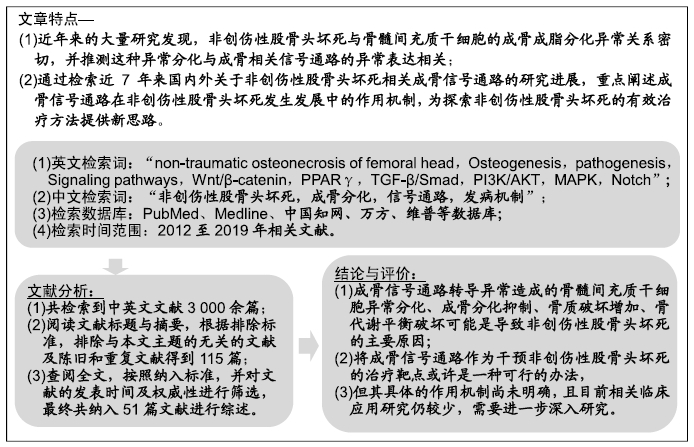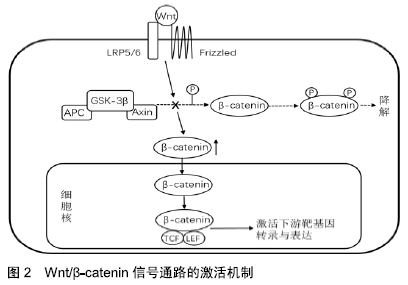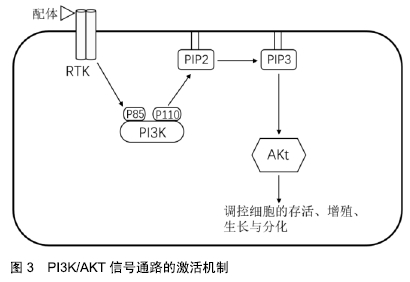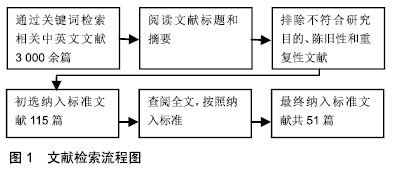[1] LIU F, WANG W, YANG L, et al.An epidemiological study of etiology and clinical characteristics in patients with nontraumatic osteonecrosis of the femoral head.J Res Med Sci.2017;22(1):15.
[2] GOU WL, LU Q, WANG X, et al.Key pathway to prevent the collapse of femoral head in osteonecrosis.Eur Rev Med Pharmacol Sci.201;19(15):2766-2474.
[3] MOHAMMED MK, SHAO C, WANG J, et al.Wnt/β-catenin signaling plays an ever-expanding role in stem cell self-renewal, tumorigenesis and cancer chemoresistance.Genes Dis.2016; 3(1):11-40.
[4] BURGERS TA, WILLIAMS BO.Regulation of Wnt/β-catenin Signaling within and from Osteocytes.Bone.2013;54(2): 244-249.
[5] YAO Q, YU C, ZHANG X, et al.Wnt/β-catenin signaling in osteoblasts regulates global energy metabolism.Bone.2017;97: 175.
[6] CHEN Z, ZOU Y, MA J, et al.Apoptosis associated with Wnt/β-catenin pathway leads to steroid-induced avascular necrosis of femoral head.BMC Musculoskelet Disord. 2015; 16(1):132.
[7] HUANG L, WANG Y, JIANG Y, et al.High levels of GSK-3β signalling reduce osteogenic differentiation of stem cells in osteonecrosis of femoral head.J Biochem.2018;163:243-251.
[8] NIE Z, CHEN S, PENG H.Glucocorticoid induces osteonecrosis of the femoral head in rats through GSK3β-mediated osteoblast apoptosis.Biochem Biophys Res Commun.2019;511:693-699.
[9] LI L, PENG X, QIN Y, et al.Acceleration of bone regeneration by activating Wnt/β-catenin signalling pathway via lithium released from lithium chloride/calcium phosphate cement in osteoporosis. Sci Rep.2017;7:45204.
[10] ELZI DJ, SONG M, HAKALA K, et al.Wnt antagonist SFRP1 functions as a secreted mediator of senescence.Mol CellBiol. 2012;32(21):4388.
[11] 张晨,李苗,马骏,等.Wnt/β-catenin信号通路在大鼠早期激素性股骨头缺血性坏死中的作用机制研究[J].中国修复重建外科杂志, 2016,30(6):661-668.
[12] ZHUN W, DONGHAI L, ZHOUYUAN Y, et al.Efficiency of Cell Therapy to GC-Induced ONFH: BMSCs with Dkk-1 Interference Is Not Superior to Unmodified BMSCs.Stem Cells Int. 2018;2018:1340252.
[13] YUAN N, LI J, LI M, et al.BADGE, a synthetic antago-nist for PPARgamma, prevents steroid - related osteone-crosis in a rabbit model.BMC Musculoskelet Disord.2018;19(1):129.
[14] KIM J, KO J.A novel PPARγ2 modulator sLZIP controls the balance between adipogenesis and osteogenesis during mesenchymal stem cell differentiation.Cell Death Differ. 2014; 21(10):1642-1655.
[15] WANG T, TENG S, ZHANG Y, et al.Role of mesenchymal stem cells on differentiation in steroid-induced avascular necrosis of the femoral head.Exp Ther Med.2017;13(2): 669-675.
[16] YU Z, FAN L, LI J, et al.Lithium prevents rat steroid-related osteonecrosis of the femoral head by β-catenin activation. Endocrine.2016;52:380-390.
[17] LI J, LI Y, WANG Y, et al.Preventive effects of siRNA targeting PPARγ gene on steroid-induced osteonecrosis in rabbits. Connect Tissue Res.2014;55(5-6):322-330.
[18] 王耀清,潘振宇,陈帆.BADGE联合锂盐通过抑制PPARγ预防家兔激素性股骨头坏死[J].武汉大学学报(医学版), 2019,40(4): 517-523.
[19] CHEN G, DENG C, LI YP.TGF-β and BMP Signaling in Osteoblast Differentiation and Bone Formation.Int J Biol Sci. 2012;8(2):272-288.
[20] WU M, CHEN G, LI YP.TGF-β and BMP signaling in osteoblast, skeletal development, and bone formation, homeostasis and disease.Bone Res.2016;4:16009.
[21] LI R, LIU J, LI Q, et al.miR-29a suppresses growth and metastasis in papillary thyroid carcinoma by targeting AKT3.Tumor Biol. 2016;37:3987-3996.
[22] MD SR, NAZNIN A, HOSSEN MJ.TGF-β/BMP signaling and other molecular events: regulation of osteoblastogenesis and bone formation. Bone Res.2015;3(1):11-30.
[23] ZHANG YE.Mechanistic insight into contextual TGF-β signaling. Curr Opin Cell Biol.2018;51:1-7.
[24] TAO J, DONG B, YANG LX, et al.TGF-β1 expression in adults with non‑traumatic osteonecrosis of the femoral head.Mol Med Rep. 2017;16:9539-9544.
[25] BAI Y, LIU Y, JIN S, et al.Expression of microRNA-27a in a rat model of osteonecrosis of the femoral head and its association with TGF-β/Smad7 signalling in osteoblasts.Int J Mol Med. 2019;43(2):850-860.
[26] YANG Y, NIAN H, TANG X, et al.Effects of the combined Herba Epimedii and Fructus Ligustri Lucidi on bone turnover and TGF-β1/Smads pathway in GIOP rats.J Ethnopharmacol. 2017; 201(Complete):91-99.
[27] HUANG Z, CHENG C, CAO B, et al.Icariin Protects against Glucocorticoid-Induced Osteonecrosis of the Femoral Head in Rats.Cell Physiol Biochem.2018;47:694-706.
[28] MANNING BD, TOKER A. AKT/PKB Signaling: Navigating the Network.Cell.2017;169(3):381-405.
[29] WANG J, MA XY, FENG YF, et al.Magnesium Ions Promote the Biological Behaviour of Rat Calvarial Osteoblasts by Activating the PI3K/Akt Signalling Pathway.Biol Trace Elem Res. 2017;179:284-293.
[30] 徐栋.microRNA-28-3p通过抑制Sox6并激活PI3K/AKT通路促进骨折愈合的研究[D].青岛:山东大学,2017.
[31] CHEN YX, TAO SC, XU ZL, et al.Novel Akt activator SC-79 is a potential treatment for alcohol-induced osteonecrosis of the femoral head.Oncotarget.2017;8(19):31065-31078.
[32] XUE XH, FENG ZH, LI ZX, et al.Salidroside inhibits steroid-induced avascular necrosis of the femoral head via the PI3K/Akt signaling pathway:In vitroandin vivostudies.Mol Med Rep. 2018;17(3):3751-3757.
[33] DENG S, DAI G, CHEN S, et al.Dexamethasone induces osteoblast apoptosis through ROS-PI3K/AKT/GSK3β signaling pathway.Biomed Pharmacother.2019;110:602-608.
[34] HU J, MAO Z, HE S, et al.Icariin protects against glucocorticoid induced osteoporosis, increases the expression of the bone enhancer DEC1 and modulates the PI3K/Akt/GSK3β/β-catenin integrated signaling pathway. Biochem. Pharmacol. 2017;136:109-121.
[35] ARTHUR SC, LEY SC.Mitogen-activated protein kinases in innate immunity[J].Nat Rev Immunol.2013;13(9):679-692.
[36] GREENBLATT MB, SHIM JH, GLIMCHER LH. Mitogen-Activated Protein Kinase Pathways in Osteoblasts. Ann Rev Cell DevBiol. 2013;29(1):63-79.
[37] THOUVEREY C, CAVERZASIO J.The p38α MAPK positively regulates osteoblast function and postnatal bone acquisition. Cell Mol Life Sci.2012;69(18):3115-3125.
[38] KIM JM, YANG YS, PARK KH, et al.The ERK MAPK Pathway Is Essential for Skeletal Development and Homeostasis.Int J Mol Sci.2019;20(8):1803-1817.
[39] 钟海波,郭祥,黄琳惠.葛根素通过ERK1/2和p38 MAPK信号通路刺激成骨分化和骨形成的机制[J].中国比较医学杂志,2019, 29(2):78-83.
[40] HAN Y, SI M, ZHAO Y, et al. Progranulin Protects Against Osteonecrosis of the Femoral Head by Activating ERK1/2 Pathway.Inflammation.2017;40:946-955.
[41] 齐振熙,万甜,吴敏瑞,等.羟基红花黄色素A不同给药方式对激素性股骨头缺血坏死模兔ERK1/2、JNK和p38蛋白表达的影响[J].中华中医药杂志,2014,29(9):2927-2930.
[42] YUE G, SONG W, XU S, et al.Role of ILK/p38 pathway in mediating the enhanced osteogenic differentiation of bone marrow mesenchymal stem cells on amorphous carbon coating. Biomater Sci.2019;7:975-984.
[43] PENTON AL, LEONARD LD, SPINNER NB.NOTCH signaling in human development and disease.Semin Cell Devl Biol. 2012;23(4):450-457.
[44] CANALIS E.Notch in skeletal physiology and disease. Osteoporos Int.2018;29:2611-2621.
[45] GURUHARSHA KG, KANKEL MW, ARTAVANIS-TSAKONAS S.The Notch signalling system: recent insights into the complexity of a conserved pathway.Nat Rev Genet.2012; 13(9):654-666.
[46] 邓宇,陈廖斌.淫羊藿苷通过激活Notch信号通路促进骨髓间充质干细胞向成骨细胞分化的实验研究[J].中医学报, 2017,32(12): 2393-2398.
[47] VIALE-BOURONCLE S, GOSAU M, MORSCZECK C.OTCH1 signaling regulates the BMP2/DLX-3 directed osteogenic differentiation of dental follicle cells.Biochem Biophys Res Commun.2014; 443(2):500-504.
[48] LI N, JIANG Y, WOOLEY PH, et al.Naringin promotes osteoblast differentiation and effectively reverses ovariectomy-associated osteoporosis.J Orthop Sci.2013;18: 478-485.
[49] YU GY, ZHENG GZ, CHANG B, et al.Naringin Stimulates Osteogenic Differentiation of Rat Bone Marrow Stromal Cells via Activation of the Notch Signaling Pathway.Stem Cells Int. 2016;2016: 7130653.
[50] ZANOTTI S, CANALIS E.Notch Signaling and the Skeleton. Endocr Rev.2016;37(3):223-253.
[51] 蔡万翔.活血通络汤在SANFH家兔造模过程中干预Notch1、HERP1及bFGF的实验研究[D].成都:成都中医药大学,2018.
|




